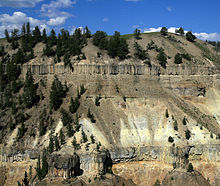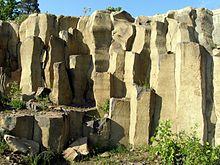
Basalt (UK: /ˈbæsɔːlt, –əlt/; US: /bəˈsɔːlt, ˈbeɪsɔːlt/) is an aphanitic (fine-grained) extrusive igneous rock formed from the rapid cooling of low-viscosity lava rich in magnesium and iron (mafic lava) exposed at or very near the surface of a rocky planet or moon. More than 90% of all volcanic rock on Earth is basalt. Rapid-cooling, fine-grained basalt is chemically equivalent to slow-cooling, coarse-grained gabbro. The eruption of basalt lava is observed by geologists at about 20 volcanoes per year. Basalt is also an important rock type on other planetary bodies in the Solar System. For example, the bulk of the plains of Venus, which cover ~80% of the surface, are basaltic; the lunar maria are plains of flood-basaltic lava flows; and basalt is a common rock on the surface of Mars.
Molten basalt lava has a low viscosity due to its relatively low silica content (between 45% and 52%), resulting in rapidly moving lava flows that can spread over great areas before cooling and solidifying. Flood basalts are thick sequences of many such flows that can cover hundreds of thousands of square kilometres and constitute the most voluminous of all volcanic formations.
Basaltic magmas within Earth are thought to originate from the upper mantle. The chemistry of basalts thus provides clues to processes deep in Earth’s interior.
Definition and characteristics




Basalt is composed mostly of oxides of silicon, iron, magnesium, potassium, aluminum, titanium,and calcium. Geologists classify igneous rock by its mineral content whenever possible, with the relative volume percentages of quartz (crystalline silica (SiO2)), alkali feldspar, plagioclase, and feldspathoid (QAPF) being particularly important. An aphanitic (fine-grained) igneous rock is classified as basalt when its QAPF fraction is composed of less than 10% feldspathoid and less than 20% quartz, with plagioclase making up at least 65% of its feldspar content. This places basalt in the basalt/andesite field of the QAPF diagram. Basalt is further distinguished from andesite by its silica content of under 52%.
It is often not practical to determine the mineral composition of volcanic rocks, due to their very fine grain size, and geologists then classify the rocks chemically, with the total content of alkali metal oxides and silica (TAS) being particularly important. Basalt is then defined as volcanic rock with a content of 45% to 52% silica and not more than 5% alkali metal oxides. This places basalt in the B field of the TAS diagram. Such a composition is described as mafic.
Basalt is usually dark grey to black in colour, due to its high content of augite or other dark-coloured pyroxene minerals, but can exhibit a wide range of shading. Some basalts are quite light-coloured due to a high content of plagioclase, and these are sometimes described as leucobasalts. Lighter basalt can be difficult to distinguish from andesite, but a common rule of thumb, used in field research, is that basalt has a color index of 35 or greater.
The physical properties of basalt reflect its relatively low silica content and typically high iron and magnesium content. The average density of basalt is 2.9 g/cm3, compared with a typical density for granite of 2.7 g/cm3. The viscosity of basaltic magma is relatively low, around 104 to 105 cP, although this is still many orders of magnitude higher than water (which has a viscosity of about 1 cP). The viscosity of basaltic magma is similar to that of ketchup.
Basalt is often porphyritic, containing larger crystals (phenocrysts) formed prior to the extrusion that brought the magma to the surface, embedded in a finer-grained matrix. These phenocrysts usually are of augite, olivine, or a calcium-rich plagioclase, which have the highest melting temperatures of the typical minerals that can crystallize from the melt and are therefore the first to form solid crystals.
Basalt often contains vesicles, formed when dissolved gases bubble out of the magma as it decompresses during its approach to the surface, and the erupted lava then solidifies before the gases can escape. When vesicles make up a substantial fraction of the volume of the rock, the rock is described as scoria.
The term basalt is at times applied to shallow intrusive rocks with a composition typical of basalt, but rocks of this composition with a phaneritic (coarser) groundmass are more properly referred to as diabase (also called dolerite) or, when more coarse-grained (crystals over 2 mm across), as gabbro. Diabase and gabbro are thus the hypabyssal and plutonic equivalents of basalt.

In the Hadean, Archean, and early Proterozoic eons of Earth’s history, the chemistry of erupted magmas was significantly different from today’s, due to immature crustal and asthenosphere differentiation. These ultramafic volcanic rocks, with silica (SiO2) contents below 45% are usually classified as komatiites.
Etymology
The word “basalt” is ultimately derived from Late Latin basaltes, a misspelling of Latin basanites “very hard stone”, which was imported from Ancient Greek βασανίτης (basanites), from βάσανος (basanos, “touchstone”). The modern petrological term basalt describing a particular composition of lava-derived rock, originates from its use by Georgius Agricola in 1546 in his work De Natura Fossilium. Agricola applied “basalt” to the volcanic black rock beneath the Bishop of Meissen’s Stolpen castle, believing it to be the same as the “basaniten” described by Pliny the Elder in AD 77 in Naturalis Historiae.
Types


On Earth, most basalt forms by decompression melting of the mantle. The high pressure in the upper mantle (due to the weight of the overlying rock) raises the melting point of mantle rock, so that almost all of the upper mantle is solid. However, mantle rock is ductile (the solid rock slowly deforms under high stress). When tectonic forces cause hot mantle rock to creep upwards, the decrease of the pressure on the ascending rock can cause its melting point to drop enough for the rock to partially melt. This produces basaltic magma.
Decompression melting can occur in a variety of tectonic settings. These include continental rifts zones, at mid-ocean ridges, above hotspots, and in back-arc basins. Basalt is also produced in subduction zones, where mantle rock rises into a mantle wedge above the descending slab. Decompression melting in this setting is enhanced by further lowering of the melting point by water vapor and other volatiles released from the slab. Each such setting produces basalt with distinctive characteristics.
- Tholeiitic basalt is relatively rich in iron and poor in alkali metals and aluminium. Included in this category are most basalts of the ocean floor, most large oceanic islands, and continental flood basalts such as the Columbia River Plateau.
- High and low titanium basalt. Basalt rocks are in some cases classified after their titanium (Ti) content in High-Ti and Low-Ti varieties. High-Ti and Low-Ti basalt has been distinguished in the Paraná and Etendeka traps and the Emeishan Traps.
- Mid-ocean ridge basalt (MORB) is a tholeiitic basalt commonly erupted only at ocean ridges and is characteristically low in incompatible elements. Although all MORBs are chemically similar, geologists recognize that they vary significantly in how depleted they are in incompatible elements. Their presence in close proximity along mid-ocean ridges is interpreted as evidence for mantle inhomogeneity.
- E-MORB, enriched MORB, is relatively undepleted in incompatible elements. E-MORB was once thought to be typical of hot spots along mid-ocean ridges, such as Iceland, but is now known to be present in many locations along mid-ocean ridges.
- N-MORB, normal MORB, is average in its content of incompatible elements.
- D-MORB, depleted MORB, is highly depleted in incompatible elements.
- Alkali basalt is relatively rich in alkali metals. It is silica-undersaturated and may contain feldspathoids, alkali feldspar, phlogopite, and kaersutite. Augite in alkali basalts is titanium-enriched augite, and low-calcium pyroxenes are never present. They are characteristic of continental rifting and hotspot volcanism.
- High-alumina basalt has greater than 17% alumina (Al2O3) and is intermediate in composition between tholeiitic basalt and alkali basalt. Its relatively alumina-rich composition is based on rocks without phenocrysts of plagioclase. These represent the low silica end of the calc-alkaline magma series and are characteristic of volcanic arcs above subduction zones.
- Boninite is a high-magnesium form of basalt that is erupted generally in back-arc basins, distinguished by its low titanium content and trace-element composition.
- Ocean island basalts include both tholeiites and alkali basalts, with tholeiite predominating early in the eruptive history of the island. These basalts are characterized by elevated concentrations of incompatible elements. This suggests that their source mantle rock has produced little magma in the past (it is undepleted).

Leave a Reply